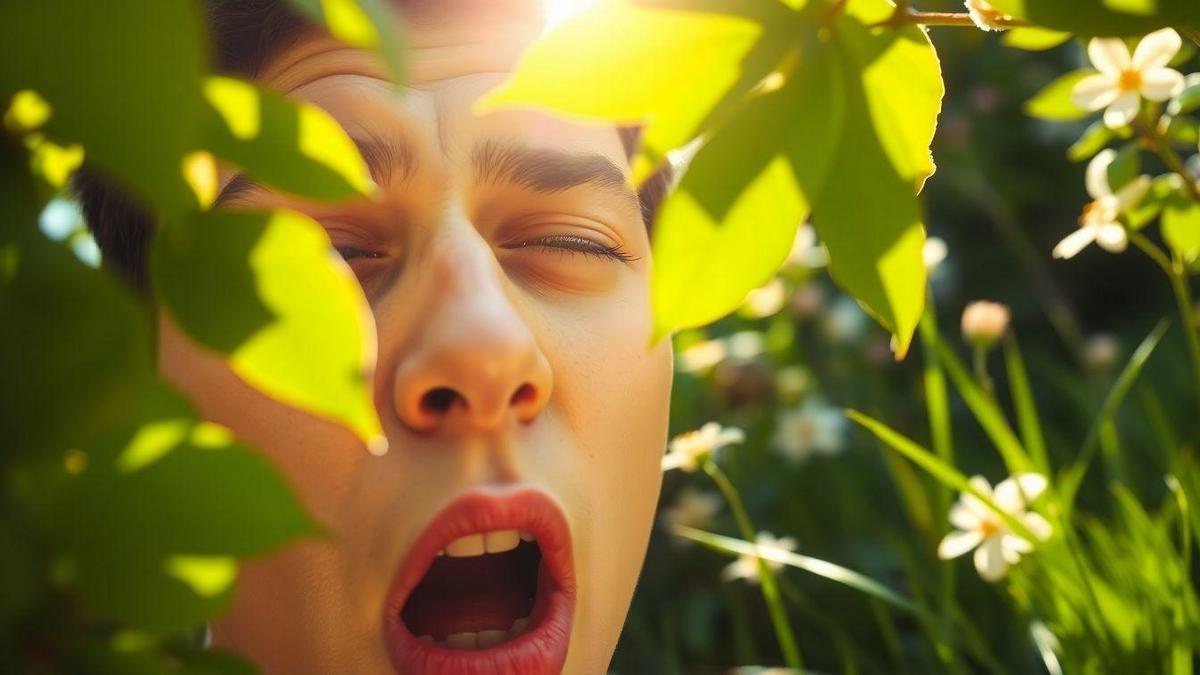Anúncios
The phenomenon of sneezing caused by sunlight is a curiosity that intrigues both scientists and laypeople. Many people have experienced this reflex without understanding its causes. Exploring this topic reveals fascinating details about the complexity of our nervous system.
Although this reaction is harmless, it can be uncomfortable in everyday situations. Therefore, understanding the factors that trigger it is essential. Investigating this reflex also contributes to a better understanding of our body’s automatic responses.
Anúncios

How Are Sunlight and Sneezing Connected?
The connection between sunlight and sneezing is a fascinating phenomenon that affects a significant portion of the population. This reaction is commonly referred to as the photic sneeze reflex or photic sneeze syndrome (PSS). It is characterized by a sudden and uncontrollable sneeze when an individual is exposed to intense light, especially sunlight. Although the exact mechanism behind this reflex is not fully understood, it is believed to involve a complex interaction of neurological factors, including the trigeminal nerve, which is responsible for facial sensations and motor functions.
When intense light enters the eyes, it can cause a rapid constriction of the pupils, which may inadvertently stimulate the trigeminal nerve. This nerve is closely associated with the sneeze reflex, leading to the involuntary action of sneezing. The phenomenon is not uncommon, with estimates suggesting that between 10% to 35% of the population may experience this reflex to varying degrees. Understanding the connection between sunlight and sneezing can provide insights into the underlying mechanisms of this reflex and its implications for those affected.
Advantages of Understanding Why Sunlight Triggers Sneezing in Some People
Understanding why sunlight triggers sneezing in some individuals can have several advantages. Firstly, it can help raise awareness about the photic sneeze syndrome, leading to better recognition and understanding of the condition. Many people may experience this reaction without knowing it is a recognized phenomenon, often attributing it to allergies or other unrelated causes. By educating individuals about PSS, they can better understand their own reactions to sunlight and avoid unnecessary concerns.
Additionally, recognizing the triggers and symptoms associated with photic sneeze syndrome can empower individuals to manage their reactions more effectively. For those who frequently experience sneezing episodes in bright light, knowing that it is a benign condition can relieve anxiety and help them develop coping strategies. This understanding can lead to a more comfortable experience when transitioning from dark environments to sunlight, reducing the likelihood of unexpected sneezing fits.
Understanding the genetic factors that contribute to photic sneeze syndrome can also provide valuable insights for researchers and healthcare professionals. Studies suggest that there may be a hereditary component to this condition, and further investigations into the genetic basis of PSS could lead to a deeper understanding of its mechanisms. This knowledge could pave the way for potential interventions or treatments for those who experience severe or disruptive symptoms.
Finally, increasing awareness and understanding of photic sneeze syndrome can foster a sense of community among those who experience this phenomenon. Individuals who share this unique reaction to sunlight may find comfort in connecting with others who have similar experiences. This sense of community can lead to support networks where individuals can exchange tips, share coping strategies, and offer mutual encouragement.
How to Effectively Manage the Sneezing Reaction to Sunlight
Managing the sneezing reaction to sunlight can be achieved through various strategies. Recognizing the symptoms of photic sneeze syndrome is the first step in effectively addressing this phenomenon. Individuals who experience frequent sneezing when exposed to intense light should observe their reactions and patterns. By being aware of the symptoms, individuals can prepare for potential sneezing episodes and take proactive steps to mitigate their impact.
Identifying the triggers related to sunlight exposure is another crucial aspect of managing the sneezing reaction. Some people may find that certain conditions, such as direct sunlight or specific times of the day, exacerbate their symptoms. By keeping a journal of sneezing occurrences and the associated environmental factors, individuals can gain insights into their specific triggers and make adjustments to their routines. This may involve avoiding intense sunlight during peak hours or seeking shade when outdoors.
Wearing sunglasses to reduce light intensity is an effective way to manage the sneezing reaction. By wearing sunglasses, individuals can protect their eyes from direct sunlight and minimize the intensity of light entering their eyes. This simple change can significantly reduce the likelihood of triggering the sneeze reflex and provide a more comfortable outdoor experience. Additionally, individuals may consider wearing wide-brimmed hats to further block sunlight from their eyes.
Consulting a healthcare professional is also a valuable step for individuals who experience severe or disruptive symptoms related to photic sneeze syndrome. A healthcare provider can offer guidance, perform assessments, and provide personalized recommendations for managing the condition. In some cases, further evaluation may be necessary to rule out other underlying conditions that may contribute to sneezing or discomfort in intense light.
Exploring genetic factors related to sneezing triggered by sunlight can also offer insights into the condition. Research suggests that photic sneeze syndrome may have a hereditary component, with certain families exhibiting a higher prevalence of the phenomenon. Understanding the genetic basis of PSS can help individuals identify potential patterns within their family history and may lead to further research on targeted interventions.
Learning about the mechanisms of light-induced sneezing can also enhance individuals’ understanding of their reactions to sunlight. Research on the neurological pathways involved in photic sneeze syndrome is ongoing, and staying informed about the latest findings can empower individuals to make informed decisions about their management strategies. By understanding the science behind the phenomenon, individuals can approach their experiences with greater knowledge and confidence.
What Is Photic Sneeze Syndrome?
Photic sneeze syndrome is an involuntary reflex triggered by intense light. It affects a significant portion of the population and is more common than one might imagine. Despite seeming unusual, this phenomenon has a well-established neurological basis.
The trigeminal nerve plays a central role in this peculiar reflex. When exposed to intense light, this nerve can be activated through cross-stimulation. This stimulus results in the automatic response of sneezing, even without nasal irritation.
Studies suggest that between 10% and 35% of people exhibit this response. The intensity and frequency of sneezing can vary according to individual factors. Although it is not harmful, it can be uncomfortable in outdoor environments.
Understanding the basis of this reflex allows for greater control over the situation. Informed individuals tend to adopt more effective preventive measures. This contributes to a more comfortable and safer daily life under sunlight.
Is There a Genetic Factor Involved?

Research indicates that genetic predisposition plays an important role. Entire families may share the tendency to sneeze under intense light. This pattern suggests the presence of a hereditary component in the phenomenon.
Studies with twins also reinforce the hypothesis of genetic influence. Identical twins show a higher coincidence in the occurrence of the reflex. This data suggests a common biological basis related to the neurological response.
A specific gene responsible for this reflex has not yet been identified. However, genetic research continues to advance to clarify the issue further. Understanding these mechanisms may bring future solutions for severe cases.
In the meantime, family recognition of the phenomenon already helps with understanding. Identifying patterns within one’s own family allows for a calmer approach. It also helps reduce unnecessary concerns about the condition.
How Does Sunlight Stimulate the Sneeze Reflex?
The entry of intense light through the eyes triggers rapid neurological reactions. This stimulus causes the pupils to contract, known as the photomotor reflex. During this process, cross-activation of the trigeminal nerve occurs.
This activation directly interferes with the pathways responsible for sneezing. The brain interprets the stimulation as a signal to initiate the reflex. Therefore, even without irritating particles in the nose, the sneeze happens.
This reaction is more common when moving from dark environments to bright areas. The abrupt contrast in brightness enhances the neurological response. More sensitive individuals may sneeze several times in this scenario.
Did You Enjoy Learning Why Sunlight Triggers Sneezing in Some People?
In conclusion, understanding why sunlight triggers sneezing in some individuals opens a world of knowledge about a unique and often misunderstood phenomenon. By recognizing the connection between sunlight and sneezing, individuals can better manage their reactions and alleviate any concerns associated with this reflex. The advantages of understanding photic sneeze syndrome go beyond personal awareness, promoting a sense of community and support among those who share this experience.
As you explore the complexities of this intriguing phenomenon, you may feel more prepared to face the challenges it presents. Whether through practical management strategies or engaging with others who experience similar reactions, the journey of understanding photic sneeze syndrome can lead to a greater appreciation for the complexities of our bodies and their responses to the environment.
Frequently Asked Questions

Why does sunlight trigger sneezing in some people?
Sunlight can cause sneezing because of a reflex called the “photic sneeze reflex.”
Does this happen to many people?
Yes! About 18-35% of people have this reflex.
Is it dangerous to sneeze because of the sun?
No, sneezing because of sunlight is not dangerous. It’s just a reflex.
How can I avoid sneezing when I’m in the sun?
You can try wearing sunglasses. This can help block the intense light.
What should I do if it’s very annoying?
If the sneezing is very bothersome, talk to a doctor. They can suggest solutions.
